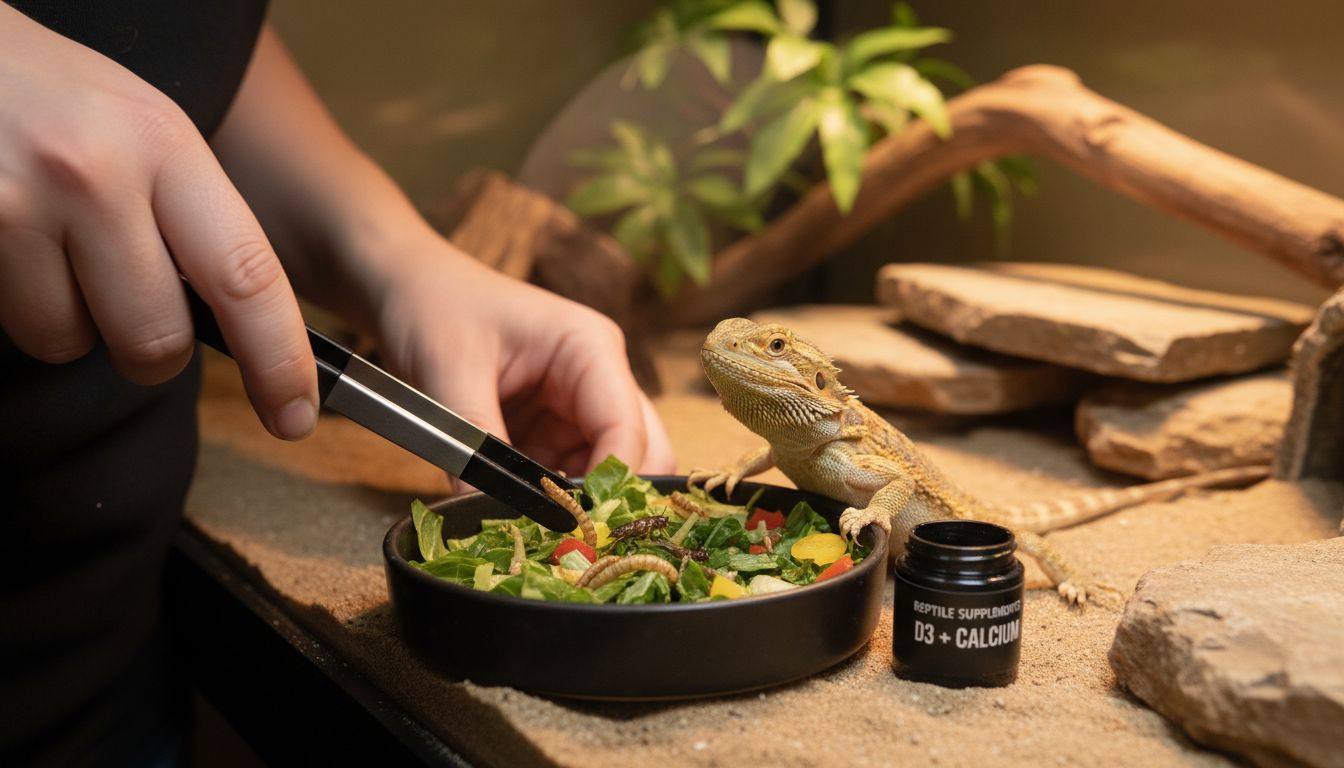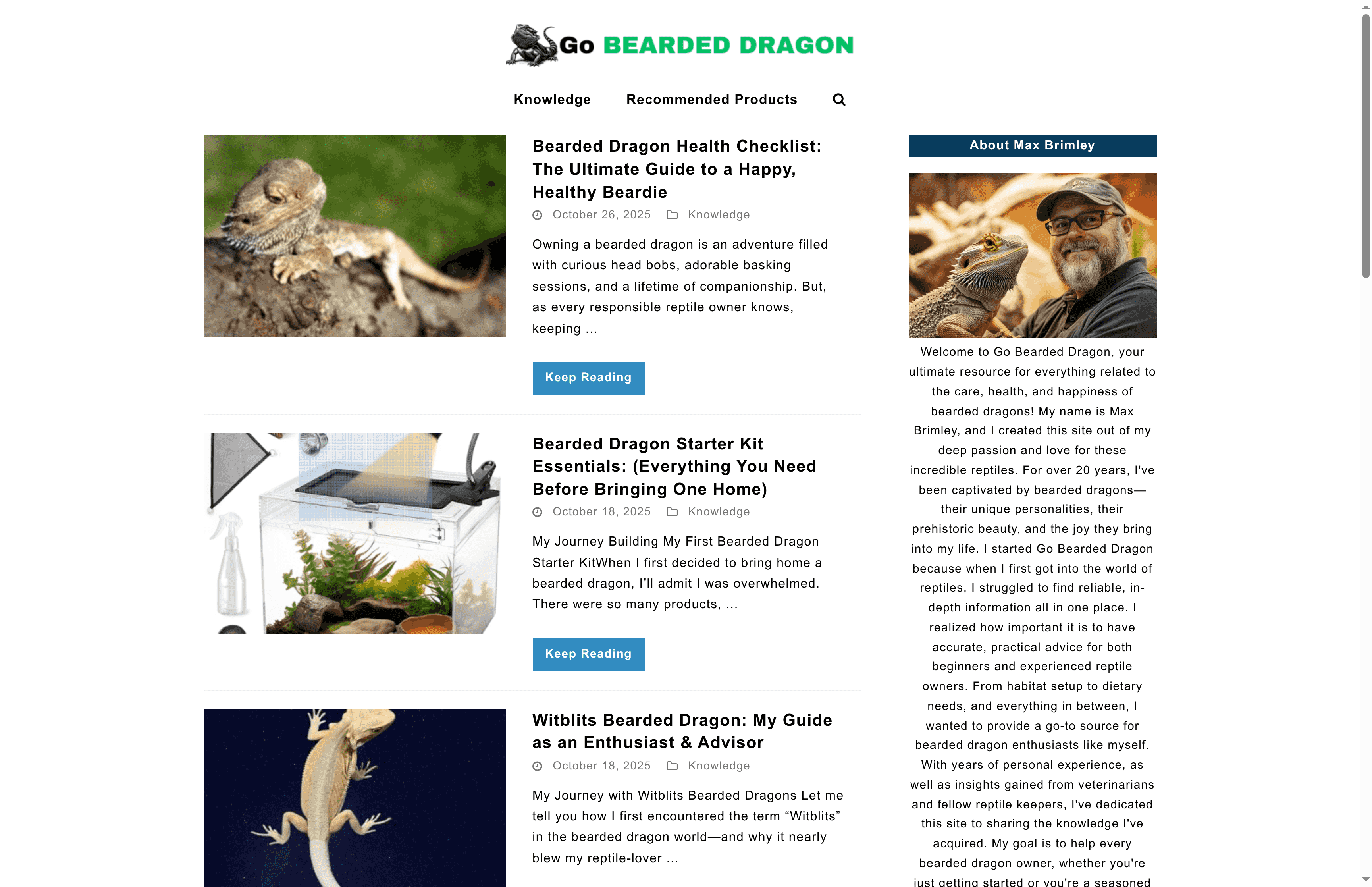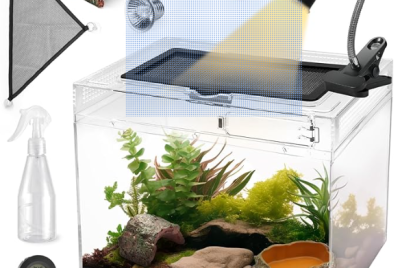How to Care for Baby Bearded Dragons Naturally Step-by-Step
More american families are discovering the joys of caring for baby bearded dragons, but nearly 40 percent of new owners encounter preventable health problems within the first year. Setting up the right environment from the start makes all the difference for these remarkable reptiles. This guide walks you through every critical step so your bearded dragon grows strong, stays safe, and thrives as part of your household.
Table of Contents
- Step 1: Prepare A Safe And Optimal Habitat
- Step 2: Set Up Proper Heating And Lighting
- Step 3: Select And Offer Balanced Nutrition
- Step 4: Monitor Health And Behavior Daily
- Step 5: Adjust Care As Your Bearded Dragon Grows
Quick Summary
| Key Insight | Explanation |
|---|---|
| 1. Create an optimal habitat | Ensure a spacious vivarium with proper heating and ventilation for your baby bearded dragon. |
| 2. Maintain proper heating and lighting | Establish a thermal gradient with basking areas between 100-108°F and UVB lighting for health. |
| 3. Offer a balanced diet | Feed a mix of insects and leafy greens, transitioning from 50% insects to 30% as they mature. |
| 4. Monitor health daily | Observe behavior and appetite to quickly identify health issues; keep a daily log for tracking. |
| 5. Adjust care as they grow | Update habitat size and diet regularly as your baby dragon matures to support healthy development. |
Step 1: Prepare a Safe and Optimal Habitat
Creating the perfect home for your baby bearded dragon is crucial for their health and happiness. According to rspca.org.uk, your habitat needs serious attention to detail.
Start by selecting a spacious vivarium that gives your little reptile friend room to explore. The recommended minimum size for an adult bearded dragon is 120cm long x 60cm high x 60cm wide, so for a baby, choose an enclosure that allows for growth but prevents feeling overwhelmed. Hvreptilerescue.org emphasizes the importance of creating a proper thermal gradient within the habitat.
Your habitat setup should include a hot side with temperatures around 90°F and a cooler side for temperature regulation. Use a combination of heat lamps and substrate that helps maintain appropriate temperatures. Ensure solid walls with good ventilation to prevent respiratory issues and create secure barriers to keep your curious baby dragon safely inside. Pro tip: Add smooth surfaces and remove any potential hazards that could cause injury during exploration.
The key is creating a microenvironment that mimics your bearded dragon’s natural habitat while providing comfort and safety. Your little scaled companion will thank you with vibrant health and energetic behavior.
Step 2: Set Up Proper Heating and Lighting
Heating and lighting are essential for your baby bearded dragon’s survival and wellbeing. Rspca.org.uk provides clear guidelines for creating the perfect thermal environment for your scaly companion.
First, establish a precise thermal gradient within the habitat. Your goal is to create a basking area with temperatures between 38–42°C (100–108°F) and a cooler zone around 22–26°C (72–79°F). According to Zen Habitats, a 100w PAR38 halogen flood bulb works excellently for generating the necessary heat. Position the heat lamp to create a basking surface temperature around 105–115°F, allowing your dragon to regulate its body temperature by moving between hot and cool zones.
UVB lighting is equally critical for your baby bearded dragon. Install a UVB fluorescent tube to support vitamin D3 synthesis and maintain a 12-hour day-night cycle that mimics natural sunlight. Pro tip: Use an infrared thermometer to monitor surface temperatures accurately and adjust your heat lamp positioning as needed. This careful attention ensures your baby dragon receives the right amount of warmth and light for healthy growth and development.
Step 3: Select and Offer Balanced Nutrition
Nutrition is the foundation of your baby bearded dragon’s health and growth. Rspca.org.uk offers critical insights into creating a diet that supports your scaly friend’s development.
As an omnivore, your baby bearded dragon needs a carefully balanced diet. According to Hvreptilerescue.org, juvenile dragons require a diet split evenly between insects and vegetables. Focus on providing live insects like crickets, dubia roaches, and mealworms as protein sources. These should be gut loaded with nutritious vegetables and dusted with calcium and vitamin D3 supplements to prevent metabolic bone disease.
Vegetables are equally important. Start introducing a variety of leafy greens such as collard greens, mustard greens, and dandelion greens. Avoid toxic plants and rotate your vegetable options to ensure a comprehensive nutrient profile. Pro tip: Chop vegetables into small pieces to make them easier for your baby dragon to eat. As your dragon grows, gradually shift the diet to 70% vegetables and 30% insects to support healthy long term development. Your attentive approach to nutrition will help your bearded dragon thrive and grow into a vibrant adult.

Step 4: Monitor Health and Behavior Daily
Keeping a watchful eye on your baby bearded dragon’s health is crucial for catching potential issues early. Rspca.org.uk provides essential guidance on monitoring your reptilian companion’s wellbeing.
Daily observation involves checking multiple aspects of your dragon’s condition. According to Hvreptilerescue.org, look for signs of good health such as alertness, consistent appetite, and normal fecal output. Pay attention to their behavior patterns tracking energy levels, eating habits, and physical appearance. Watch for warning signs like lethargy, reduced appetite, unusual feces, or changes in skin color and texture.
Regular handling helps you become familiar with your dragon’s normal behavior and quickly identify potential health concerns. Schedule routine veterinary check-ups with a reptile specialist to ensure comprehensive health monitoring. Pro tip: Keep a daily log of your dragon’s eating habits, weight, and behavior to help track their development and spot any subtle changes. Your consistent attention and proactive approach will help your baby bearded dragon grow into a healthy adult companion.
Step 5: Adjust Care as Your Bearded Dragon Grows
As your baby bearded dragon transitions through different life stages, their care requirements will evolve significantly. Rspca.org.uk provides crucial insights into the changing needs of these fascinating reptiles.
Dietary modifications are perhaps the most important adjustment. According to Hvreptilerescue.org, juvenile dragons require a diet rich in protein with a 50/50 split between insects and vegetables. As they mature, gradually transition to a diet composed of 70% vegetables and 30% insects for adult dragons. Simultaneously, you will need to increase your enclosure size to accommodate their growing body. Expect to upgrade your habitat every few months to ensure adequate space for exploration and comfortable movement.
Temperature and lighting requirements will also shift as your dragon matures. Maintain careful observation of their behavior and adjust heat gradients accordingly. Pro tip: Keep detailed records of your dragon’s growth, dietary changes, and behavioral shifts to track their development effectively. Check out our bearded dragon young care guide for more detailed insights into each growth stage. Your attentive approach will help your scaly companion thrive through every phase of their life.

Ensure Your Baby Bearded Dragon Thrives with Expert Guidance and Resources
Caring for a baby bearded dragon can feel overwhelming with all the right habitat, heating, and nutrition requirements to balance. This article highlights the key challenges such as creating a safe thermal gradient, maintaining proper UVB lighting, and adjusting diet as your dragon grows. Many owners worry about missing crucial signs of illness or providing the perfect environment to encourage vibrant health and natural behavior.

Take control of your care journey today with comprehensive advice and tailored solutions from gobeardeddragon.com. Our site offers detailed guides on heating and lighting setups, balanced nutrition, and daily health monitoring. Explore our care guides to deepen your understanding and feel confident in every stage of your dragon’s growth. Visit now to make your baby bearded dragon’s wellbeing your top priority and turn challenges into rewarding experiences!
Frequently Asked Questions
How do I create a suitable habitat for my baby bearded dragon?
To create a suitable habitat, select a vivarium that’s at least 120cm long, 60cm high, and 60cm wide. Ensure it has a thermal gradient with a basking area around 90°F and a cooler side for temperature regulation.
What type of heating and lighting do baby bearded dragons need?
Baby bearded dragons need a basking area with temperatures between 100–108°F and UVB lighting for vitamin D3 synthesis. Install a heat lamp to maintain these temperatures and ensure a 12-hour day-night cycle.
What should I feed my baby bearded dragon?
Feed your baby bearded dragon a balanced diet that consists of 50% insects and 50% vegetables. Include live insects like crickets and gut-load them with nutritious vegetables to promote healthy growth.
How can I monitor the health of my baby bearded dragon?
Monitor your baby bearded dragon by observing its alertness, appetite, and fecal output daily. Keep a log of its eating habits and behavior to easily spot any potential health issues.
When do I need to adjust the care for my growing bearded dragon?
Adjust the care for your bearded dragon as it matures by changing its diet to a 70% vegetable and 30% insect ratio. Upgrade its enclosure size every few months to ensure adequate space for exploration and movement.
What signs should I look for to know if my bearded dragon is healthy?
Look for signs of health like alertness, a healthy appetite, and normal feces. Notice any changes in behavior, skin color, or energy levels that could indicate health issues.




